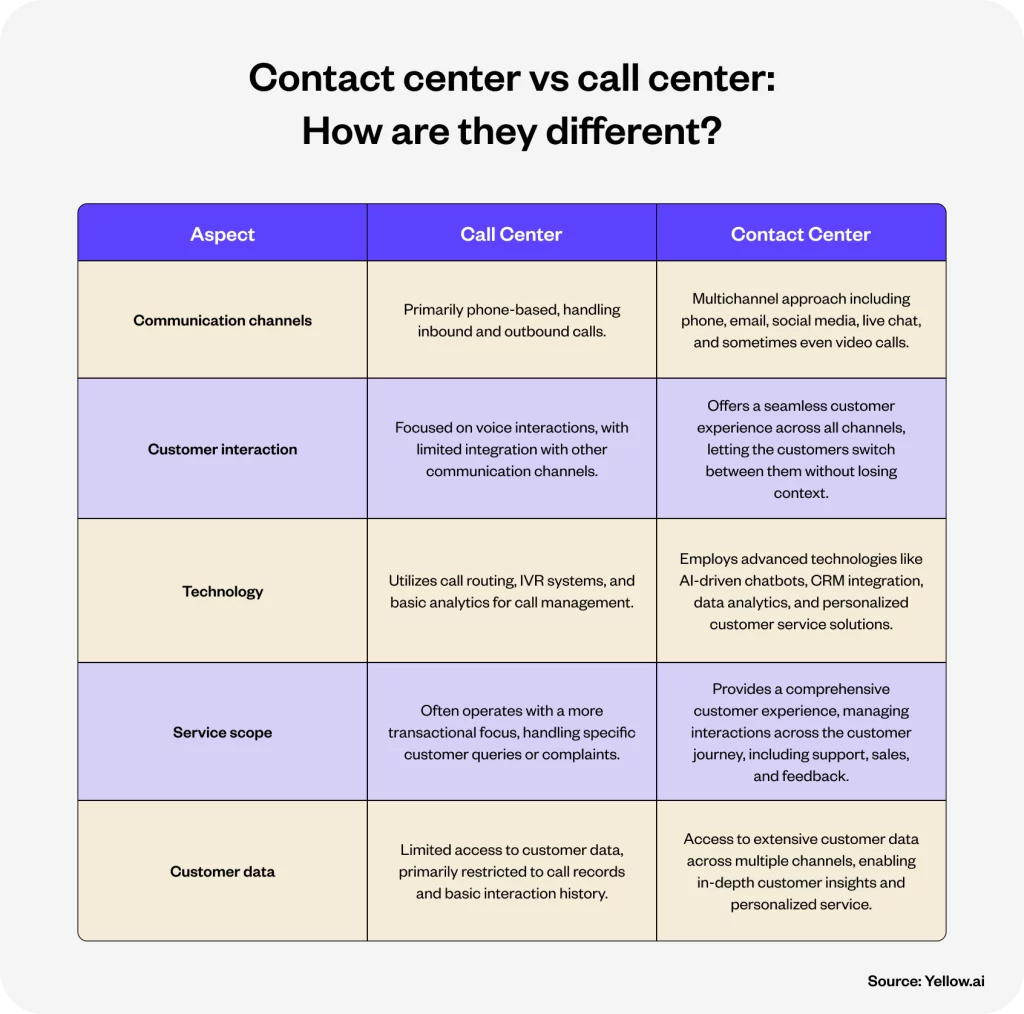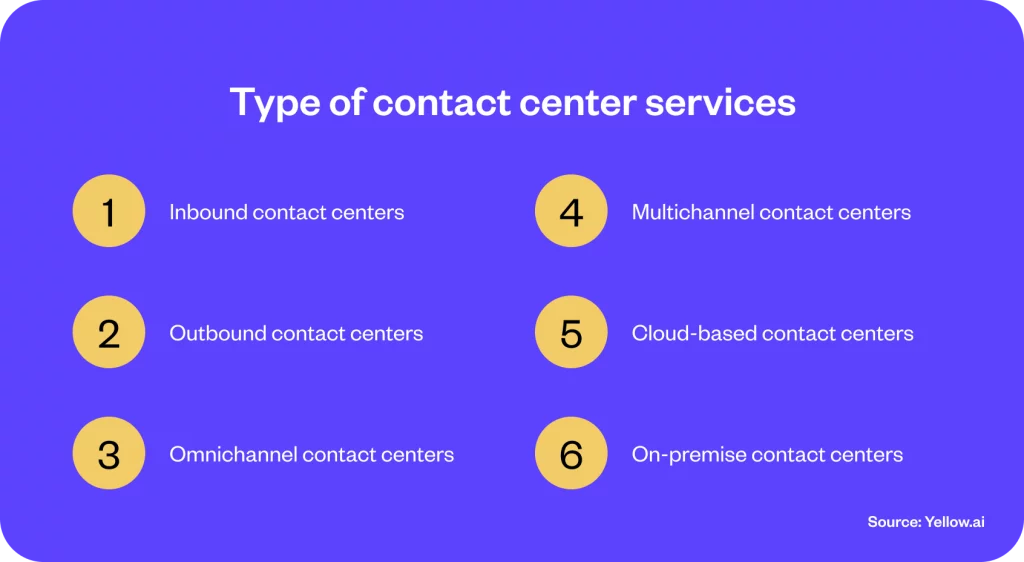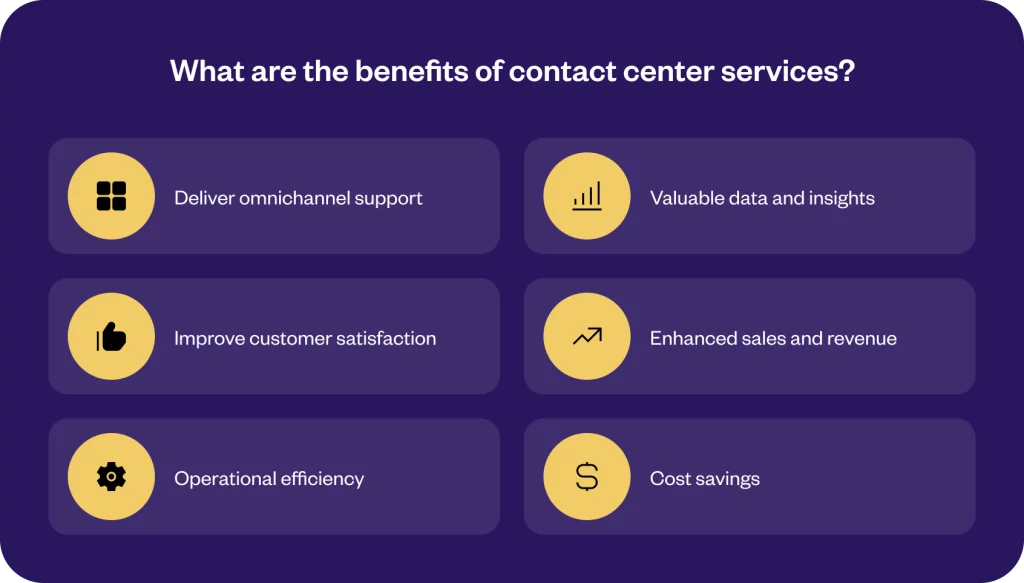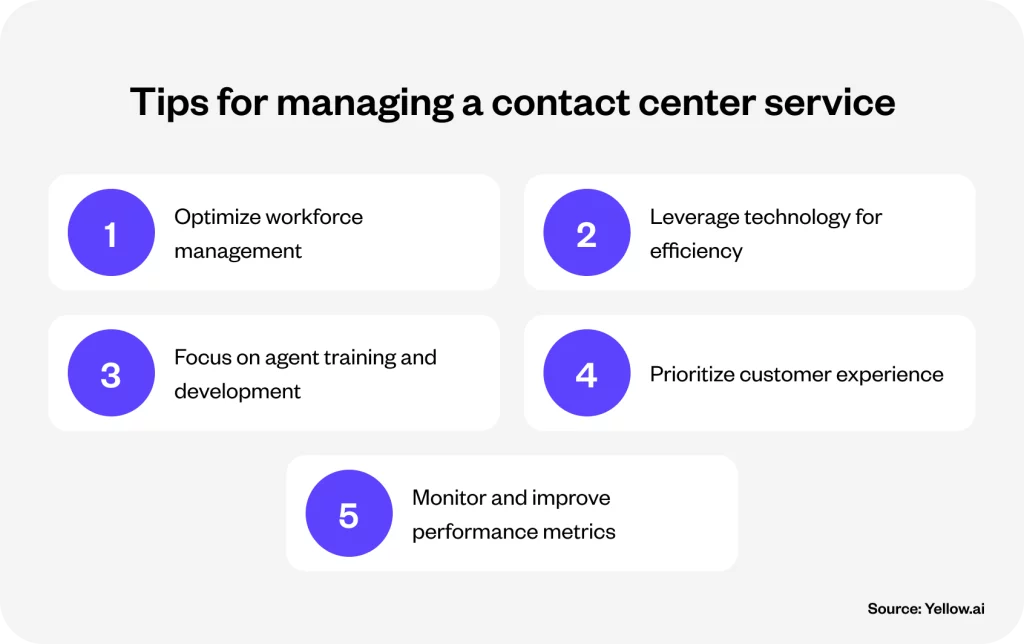Executive summary
Delve into the core of contact center services, pivotal for modern businesses. This blog explains the transformation from traditional call centers to advanced, cloud-based contact centers, highlighting their roles, types, and the integration of AI and automation. It’s a guide to understanding how these services boost customer satisfaction and streamline operations and why they are indispensable in today’s fast-paced business environment.
The customer service domain is rapidly evolving, with contact center services at the forefront, steering businesses toward a future where every customer interaction counts. These centers are more than just call response hubs; they are comprehensive service ecosystems leveraging technologies like AI to offer personalized, efficient support across multiple channels. The seamless integration of digital tools and human empathy enhances customer experiences. It also bolsters operational agility, making contact center services a cornerstone for businesses aiming to excel in customer engagement and retention.
Related must-reads:
- Contact center automation: Revolutionize your customer service
- Contact center experience: Types + Ways to improve
- Contact center outsourcing – Benefits & challenges
- Call center software – A Complete Guide [2024]
What are contact center services?
Contact center services handle customer interactions across multiple platforms, such as phone, email, chat, and social media. Unlike traditional call centers focused on phone calls, contact centers offer a broader range of services to meet customers on their preferred channels. This approach helps businesses deliver timely support and improves overall customer experience.
For companies, leveraging contact center services means prioritizing customer needs and streamlining communication. It’s about efficiently resolving issues and gaining insights to enhance service quality. Contact centers are vital in building strong customer relationships, ensuring businesses can connect with their consumers effectively and gather feedback for continuous improvement.
Contact center vs call center: How are they different?
Understanding the nuances between contact centers and call centers is crucial for businesses aiming to optimize their customer service strategy. While both serve as communication hubs for customer interactions, their operational models and capabilities set them apart.
Call centers primarily focus on voice communication and handling inbound and outbound calls. They’re traditionally seen as cost centers, emphasizing volume and efficiency in handling phone queries. On the other hand, contact centers represent a more integrated approach, offering multi-channel support, including email, social media, live chat, and more. This omnichannel strategy enables a seamless customer experience across various platforms.

Let’s delve into the distinct characteristics of each:
| Aspect | Call Center | Contact Center |
| Communication channels | Primarily phone-based, handling inbound and outbound calls. | Multichannel approach including phone, email, social media, live chat, and sometimes even video calls. |
| Customer interaction | Focused on voice interactions, with limited integration with other communication channels. | Offers a seamless customer experience across all channels, letting the customers switch between them without losing context. |
| Technology | Utilizes call routing, IVR systems, and basic analytics for call management. | Employs advanced technologies like AI-driven chatbots, CRM integration, data analytics, and personalized customer service solutions. |
| Service scope | Often operates with a more transactional focus, handling specific customer queries or complaints. | Provides a comprehensive customer experience, managing interactions across the customer journey, including support, sales, and feedback. |
| Customer data | Limited access to customer data, primarily restricted to call records and basic interaction history. | Access to extensive customer data across multiple channels, enabling in-depth customer insights and personalized service. |
Type of contact center services
Understanding the various types of contact center services is essential for businesses to choose the suitable model that aligns with their operational goals and customer engagement strategies. Here’s an overview of the different types of contact center services, each tailored to specific business requirements and customer interaction styles.

1. Inbound contact centers
Inbound contact centers focus on managing incoming customer communications. These centers primarily deal with customer inquiries, support, order processing, and technical assistance. They are the first point of contact for customers seeking help or information, making them critical in maintaining customer satisfaction and loyalty.
Typical use cases:
- Telecommunications companies handling service queries and technical support
- Healthcare providers offering patient support and appointment scheduling
- Financial institutions managing account inquiries and transaction assistance
2. Outbound contact centers
Outbound contact centers are proactive in nature, where agents initiate contact with potential or existing customers. These centers are vital for telemarketing, lead generation, customer surveys, and feedback collection. Outbound services help businesses expand their market reach, promote new products, and gather valuable customer insights.
Typical use cases:
- Market research firms conducting surveys and collecting consumer insights
- Telemarketing companies promoting products and services
- Debt collection agencies following up on overdue payments
3. Omnichannel contact centers
Omnichannel contact centers give a seamless customer experience across various communication channels, including voice, email, chat, social media, and more. They ensure continuity in customer interactions, facilitating customers’ switching between different channels without losing context or repeating information, thereby offering a cohesive and integrated customer service experience.
Typical use cases:
- Retail and ecommerce businesses providing integrated customer support across various channels
- Technology companies offering consistent support and service across multiple touchpoints
- Service providers that require continuous customer engagement and support continuity
4. Multichannel contact centers
Multichannel contact centers allow interactions through various channels but operate in silos, meaning the customer experience might not be as seamless as with omnichannel centers. Each channel functions independently, which can sometimes lead to fragmented customer experiences.
Typical use cases:
- Government agencies offering specific services through dedicated channels
- Educational institutions providing admissions, support, and information services across separate platforms
5. Cloud-based contact centers
Cloud-based contact centers are hosted on Internet servers, allowing remote service delivery and management. This model offers flexibility, scalability, and access to advanced analytics and integration capabilities, making it a popular choice for businesses looking to modernize their contact center services.
Typical use cases:
- Startups and SMEs needing scalable, cost-effective customer service solutions
- Global enterprises managing customer interactions across different regions and time zones
- Companies with a remote workforce aiming to provide flexible customer support options
6. On-premise contact centers
On-premise contact centers rely on physical infrastructure located within a company’s premises. This traditional model offers complete control over the contact center operations and data, suitable for businesses with specific regulatory compliance requirements or those prioritizing data security.
Typical use cases:
- Government defense agencies requiring secure and controlled communication channels
- Financial sector firms needing to adhere to strict regulatory compliance and data security
- Healthcare providers handling sensitive patient data and requiring robust privacy controls
What are the benefits of contact center services?
Understanding the advantages of contact center services helps businesses appreciate their impact on customer relations and operational efficiency. Each benefit addresses specific challenges, contributing to a company’s overall success and growth.

1. Deliver omnichannel support
Customers engage through various channels, often seeking the convenience of switching between them. Traditional call centers may struggle to maintain continuity across these interactions. Omnichannel support in contact centers solves this by providing a cohesive experience, allowing customers to move seamlessly from one channel to another without losing context.
Related read: Omnichannel customer service – [Strategy + Examples]
This continuity enhances customer satisfaction, eliminating the need for repeated explanations. For instance, a customer starting a conversation via chat and then moving to a phone call will not have to reintroduce their issue, making the experience smoother and more efficient.
2. Improve customer satisfaction
Businesses face the challenge of meeting diverse customer preferences and expectations. Contact centers improve satisfaction by offering multiple communication avenues, allowing customers to choose the most convenient one for their needs, leading to more effective and satisfying interactions.
Related read: How to improve customer satisfaction in 2024?
A customer dealing with an urgent issue can quickly reach out via phone, while another preferring to communicate in writing might use email or chat. This flexibility leads to improved perceptions of the brand and higher customer loyalty.
3. Operational efficiency
It can be time-consuming and laborious to manage a large number of client contacts that occur across several channels. Contact centers streamline these processes through automation and intelligent routing, ensuring customers are quickly connected to the appropriate agent or resource.
This efficiency reduces wait times and increases the number of customers served, directly benefiting businesses like airlines or retail companies, where timely customer service can significantly impact customer retention and satisfaction.
4. Valuable data and insights
Gathering and analyzing customer interaction data across various channels can be challenging. Contact centers consolidate this data, providing valuable insights into customer behavior and preferences, which can inform business strategies and improve service offerings.
By analyzing trends and customer feedback, a company can identify areas for improvement or investment, such as a telecom business discovering the need for better online support services based on customer interaction data.
Related read: Customer Feedback: Types + 8 Ways to Collect It
5. Enhanced sales and revenue
Expanding sales and revenue streams in a competitive market can be difficult. Contact centers facilitate this by enabling cross-selling and upselling opportunities through direct customer interactions across various touchpoints.
Agents can leverage customer interaction history to offer relevant additional products or services, enhancing customer value and increasing revenue, as seen in the financial services industry, where contact centers play a pivotal role in promoting new financial products.
6. Cost savings
Reducing operational costs while maintaining high-quality customer service is a significant challenge for businesses. Contact centers address this by improving efficiency and reducing the need for physical infrastructure and personnel through automation and outsourcing.
The consolidation of services and adoption of cloud-based solutions result in lower overhead costs and the ability to scale operations according to demand, which is particularly beneficial for startups and SMEs looking to optimize their customer service investments.
Tips for managing a contact center service
Efficiently managing a contact center service is pivotal for businesses aiming to enhance customer experience and operational productivity. Here are key strategies and practical tips for optimizing contact center operations.

1. Optimize workforce management
Effective workforce management ensures that the right number of agents with the necessary skills are available at the right times. It involves forecasting demand, scheduling staff, and monitoring real-time adherence to meet customer service levels and minimize wait times.
Implementation strategies:
- Use historical data to predict call volume and schedule staff accordingly.
- Implement workforce management software for accurate forecasting and scheduling.
- Monitor real-time adherence and adjust staffing levels as needed.
- Provide flexible scheduling options to accommodate peak times.
2. Leverage technology for efficiency
Utilizing the latest technology in contact centers can significantly improve operational efficiency and customer satisfaction. It includes advanced telephony systems, CRM integration, omnichannel platforms, and AI-driven tools like Yellow.ai chatbots and analytics.
Implementation strategies:
- Implement an integrated CRM system to provide a 360-degree view of the customer.
- Use AI-powered chatbots to handle routine inquiries and free up agents for complex issues.
- Adopt an omnichannel platform to ensure seamless customer interactions across channels.
- Invest in analytics tools to gain insights and optimize service delivery.
3. Focus on agent training and development
The performance of contact center agents directly impacts customer satisfaction. Thorough training and continuing development initiatives are crucial to ensuring that agents have the knowledge and abilities to provide outstanding service.
Implementation strategies:
- Develop a structured training program covering product knowledge, communication skills, and customer service etiquette.
- Offer regular coaching sessions and feedback to agents.
- Encourage professional development through workshops, courses, and certifications.
- Implement a mentorship program to foster skill sharing and team collaboration.
4. Prioritize customer experience
Enhancing the customer experience should be at the core of contact center operations. It involves effectively addressing customer issues, anticipating their needs, and exceeding their expectations.
Related read: 10 Reasons why customer experience is important?
Implementation strategies:
- Train agents to not just resolve issues but also to provide personalized and proactive service.
- Monitor customer satisfaction through surveys, feedback, and social media.
- Implement quality assurance measures to ensure high service standards.
- Regularly review customer interactions and identify areas for improvement.
5. Monitor and improve performance metrics
Keeping track of key performance indicators (KPIs) helps managers understand how well the contact center is performing against its goals. Regular monitoring and analysis of these metrics can highlight areas for improvement and inform strategic decisions.
Related read: 31 Call center metrics and KPIs to enhance the CX
Implementation strategies:
- Define clear KPIs such as Average Handle Time (AHT), First Call Resolution (FCR), Customer Satisfaction Score (CSAT), and Net Promoter Score (NPS).
- Use dashboards and reporting tools to track performance metrics in real-time.
- Conduct regular performance reviews and adjust strategies as needed.
- FoPromote a culture of constant improvement by encouraging feedback and innovation from agents.
Success stories

Hyundai boosts revenue and improves customer service with AI automation
Explore how Yellow.ai’s automation led to ~1000 car sales, a 10% retail conversion rate, and over 1.4 million user impressions

Pelago reimagines customer experience with generative AI powered conversational AI agents
Within a mere six weeks of going live, Pelago not only onboarded over 5,000 users but also achieved a striking 50% deflection rate!
Conclusion – The future of contact center technology
The future of contact center technology is not just about adopting new tools but reimagining customer service as a strategic asset for business growth. As we move forward, the integration of AI, machine learning, and cloud-based solutions will continue to transform contact centers into dynamic, customer-focused hubs. These advancements promise more personalized, efficient, and intelligent customer interactions, paving the way for businesses to differentiate themselves in a competitive market.
Yellow.ai emerges as a leading partner in this transformative journey, offering innovative AI-driven solutions that empower contact centers to exceed customer expectations. With Yellow.ai, businesses can harness the power of advanced analytics, automation, and omnichannel support to deliver exceptional service experiences. The blend of technology and human empathy that Yellow.ai facilitates will be instrumental in defining the success of contact centers in the years to come.
Frequently asked questions (FAQs)
How can contact centers improve customer service?
Contact centers improve customer service by providing timely, efficient, and personalized support across multiple channels. By leveraging data analytics, they gain insights into customer preferences and behavior, allowing for proactive service and tailored interactions, significantly enhancing customer satisfaction and loyalty.
How do contact centers utilize AI and automation?
Contact centers utilize AI and automation to streamline operations, provide round-the-clock customer support, and analyze vast amounts of data for actionable insights. AI-driven chatbots handle routine inquiries, while automation tools ensure efficient routing of customer interactions, optimizing the workload of human agents and improving service delivery.
What are the key use cases of contact centers?
Key use cases of contact centers include handling customer inquiries, providing technical support, managing orders and transactions, conducting market research, and executing sales and marketing campaigns. They serve as critical touchpoints for customer engagement, support, and feedback across various industries.
What role does empathy play in contact center customer service?
Empathy in contact center customer service is vital for understanding and addressing customers’ emotional needs. It builds trust and rapport, leading to more effective communication and problem-solving. Empathetic service fosters positive customer relationships, enhances satisfaction, and promotes customer loyalty and advocacy.
What types of services do contact centers provide?
Contact centers are versatile in their offerings, extending beyond mere call handling to include support across multiple channels such as voice calls, emails, live chats, and social media interactions. Their services encompass addressing customer queries, providing technical support, facilitating sales and marketing activities, managing financial transactions, and coordinating emergency responses. This multifaceted approach ensures that all customer needs are met promptly and efficiently, regardless of the communication channel they prefer.
What are contact centers as a service (CCaaS), and what are their benefits?
CCaaS, or Contact Center as a Service, represents a cloud-based model that enables organizations to utilize a full suite of contact center solutions hosted online, eliminating the need for extensive on-site infrastructure. This model is prized for its scalability, allowing businesses to adjust resources based on demand easily. It offers cost-saving advantages by reducing the need for physical infrastructure and maintenance. Furthermore, CCaaS provides the flexibility to innovate and integrate the latest technologies and analytics, empowering businesses to enhance customer experiences continually and respond swiftly to evolving market trends and customer expectations.






















